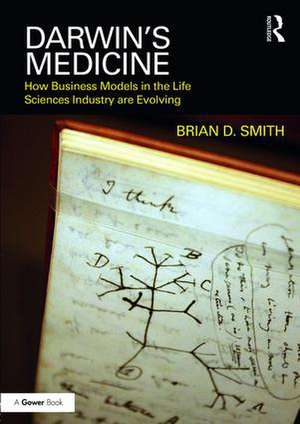Darwin's Medicine: How Business Models in the Life Sciences Industry are Evolving
Autor Brian D. Smithen Limba Engleză Hardback – 19 oct 2016
Through the lens of evolutionary science, Professor Smith explores the speciation of new business models in the Life Sciences Industry. This sophisticated and highly original approach offers insights into:
- The mechanisms of evolution in this exceptional industry;
- The six great technological and social shifts that are shaping its landscape;
- The emergence of 26 distinct, new business models; and
- The lessons that enable firms to direct and accelerate their own evolution.
The book is essential reading for anyone working in or studying the pharmaceutical, medical technology and related sectors. It provides a unique and novel way of making sense of the transformation we can see going on around us and a practical, focused approach to managing a firm’s evolutionary trajectory.
| Toate formatele și edițiile | Preț | Express |
|---|---|---|
| Paperback (1) | 211.77 lei 6-8 săpt. | |
| Taylor & Francis – 24 iun 2024 | 211.77 lei 6-8 săpt. | |
| Hardback (1) | 768.46 lei 6-8 săpt. | |
| Taylor & Francis – 19 oct 2016 | 768.46 lei 6-8 săpt. |
Preț: 768.46 lei
Preț vechi: 1029.92 lei
-25% Nou
Puncte Express: 1153
Preț estimativ în valută:
147.04€ • 153.54$ • 121.42£
147.04€ • 153.54$ • 121.42£
Carte tipărită la comandă
Livrare economică 15-29 aprilie
Preluare comenzi: 021 569.72.76
Specificații
ISBN-13: 9781472420718
ISBN-10: 1472420713
Pagini: 296
Ilustrații: 56 Line drawings, black and white; 16 Halftones, black and white; 13 Tables, black and white
Dimensiuni: 174 x 246 x 23 mm
Greutate: 0.69 kg
Ediția:1
Editura: Taylor & Francis
Colecția Routledge
Locul publicării:Oxford, United Kingdom
ISBN-10: 1472420713
Pagini: 296
Ilustrații: 56 Line drawings, black and white; 16 Halftones, black and white; 13 Tables, black and white
Dimensiuni: 174 x 246 x 23 mm
Greutate: 0.69 kg
Ediția:1
Editura: Taylor & Francis
Colecția Routledge
Locul publicării:Oxford, United Kingdom
Public țintă
Professional Practice & DevelopmentCuprins
Part 1: The Future of Pharma - Reprise
1. Introduction and an Invitation to Skip a Chapter
2. An Important Industry at Risk
3. The Best Idea Anyone Has Ever Had
4. The Biologists Got There First
5. Applying Evolutionary Theory to the Pharmaceutical and Medical Technology Sectors
6. Explaining the Industry’s Past
7. Predicting the Future of Pharma and Medtech
8. Practical Implications for an Evolving Industry
9. Watching the Future Unfold
Part 2: An Immeasurably Superior Power
10. Introduction: The Emergent Pressures of Selection
11. Selection Pressures Emerging from the Social Environment
12. Selection Pressures Emerging from the Technological Environment
13. Asking the Right Questions
Part 3: Evolution is Cleverer Than You Are
14. Introduction: Orgel’s Second Law
15. Technological Innovator Species Emerging in the Government Payer Habitat
16. Technological Innovator Species Emerging in Patient Payer Habitats
17. Operationally Excellent Species Emerging in the Government Payer Habitat
18. Operationally Excellent Species Emerging in Patient Payer Habitats
19. Customer Intimate Species Emerging in the Government Payer Habitat
20. Customer Intimate Species Emerging in Patient Payer Habitats
21. A Big Bang of Life Science Business Models
Part 4: Guiding the Blind Watchmaker
22. Introduction: From Description to Prescription
23. Which Fitness Peak(s) Should We Climb?
24. What Capabilities Does Our New Business Model Need?
25. How Should We Design a Capable Holobiont?
26. How Do We Build Our Core Capabilities?
1. Introduction and an Invitation to Skip a Chapter
2. An Important Industry at Risk
3. The Best Idea Anyone Has Ever Had
4. The Biologists Got There First
5. Applying Evolutionary Theory to the Pharmaceutical and Medical Technology Sectors
6. Explaining the Industry’s Past
7. Predicting the Future of Pharma and Medtech
8. Practical Implications for an Evolving Industry
9. Watching the Future Unfold
Part 2: An Immeasurably Superior Power
10. Introduction: The Emergent Pressures of Selection
11. Selection Pressures Emerging from the Social Environment
12. Selection Pressures Emerging from the Technological Environment
13. Asking the Right Questions
Part 3: Evolution is Cleverer Than You Are
14. Introduction: Orgel’s Second Law
15. Technological Innovator Species Emerging in the Government Payer Habitat
16. Technological Innovator Species Emerging in Patient Payer Habitats
17. Operationally Excellent Species Emerging in the Government Payer Habitat
18. Operationally Excellent Species Emerging in Patient Payer Habitats
19. Customer Intimate Species Emerging in the Government Payer Habitat
20. Customer Intimate Species Emerging in Patient Payer Habitats
21. A Big Bang of Life Science Business Models
Part 4: Guiding the Blind Watchmaker
22. Introduction: From Description to Prescription
23. Which Fitness Peak(s) Should We Climb?
24. What Capabilities Does Our New Business Model Need?
25. How Should We Design a Capable Holobiont?
26. How Do We Build Our Core Capabilities?
Notă biografică
Professor Brian D. Smith began his career as a research chemist in a pharmaceutical R&D lab and then spent 20 years in technical and marketing roles before becoming an academic, author and adviser. Working at The University of Hertfordshire and SDA Bocconi, two of Europe's leading business schools, his research focuses on strategy creation and implementation in pharmaceutical and medical technology markets. Brian also runs a specialist consultancy that advises many of the world's largest companies in this sector. He is editor of the Journal of Medical Marketing, has written and co-written three major books, including The Future of Pharma (Gower, 2011), and published many practitioner articles - all of which can be seen at www.pragmedic.com.
Descriere
Darwin’s Medicine examines how pharmaceutical, medical technology and other companies are adapting their strategies, structures, capabilities and other aspects of their business model. In this sequel to his successful The Future of Pharma (Gower, 2011), Brian Smith takes a global perspective, reflecting the nature of the industry and its environment. Illustrated with case examples, Darwin’s Medicine looks at the continuing evolution of the pharmaceutical industry and strategic management research.
